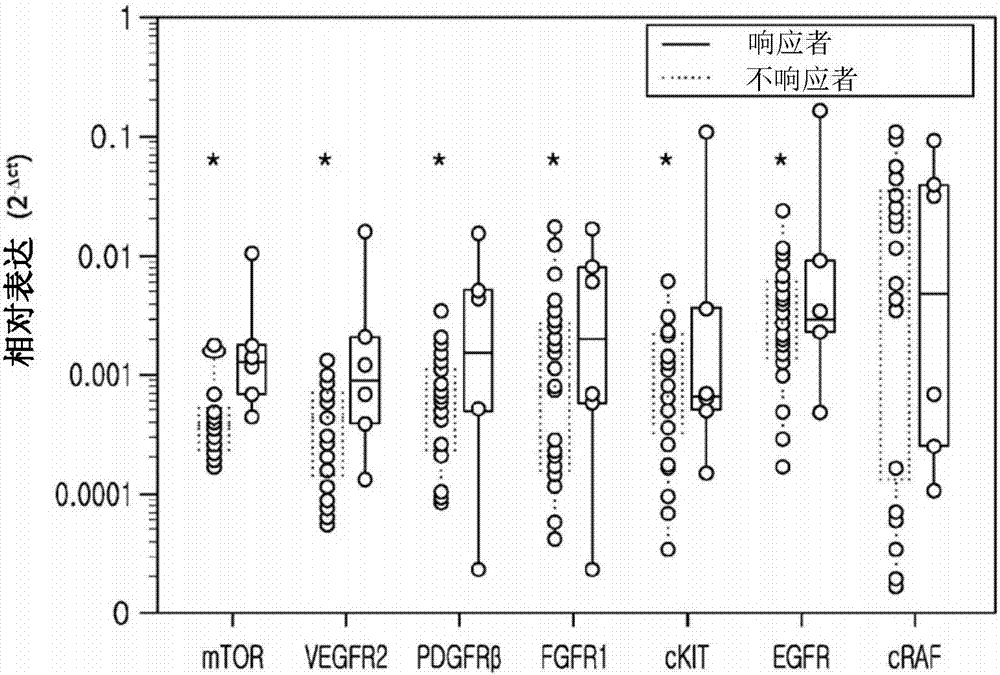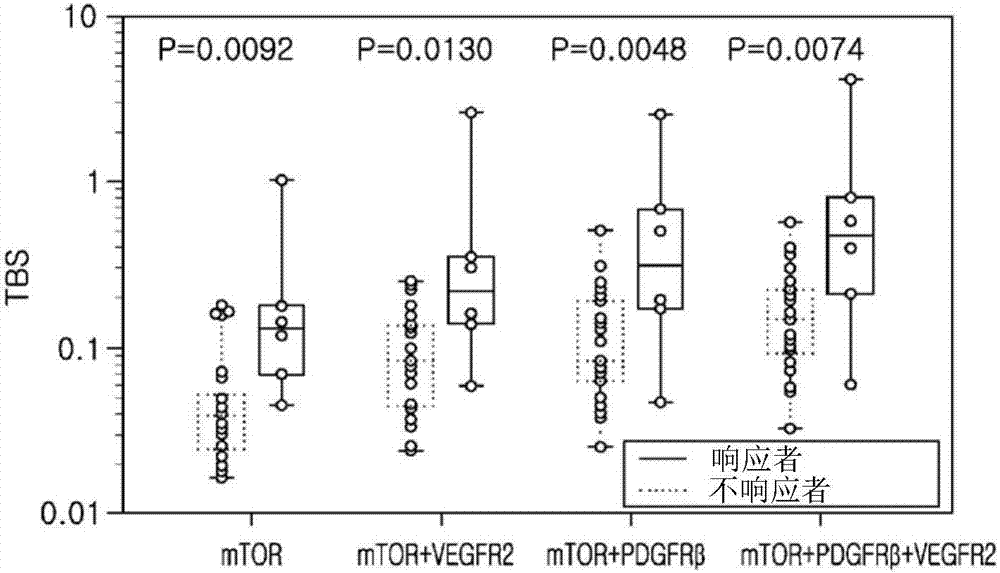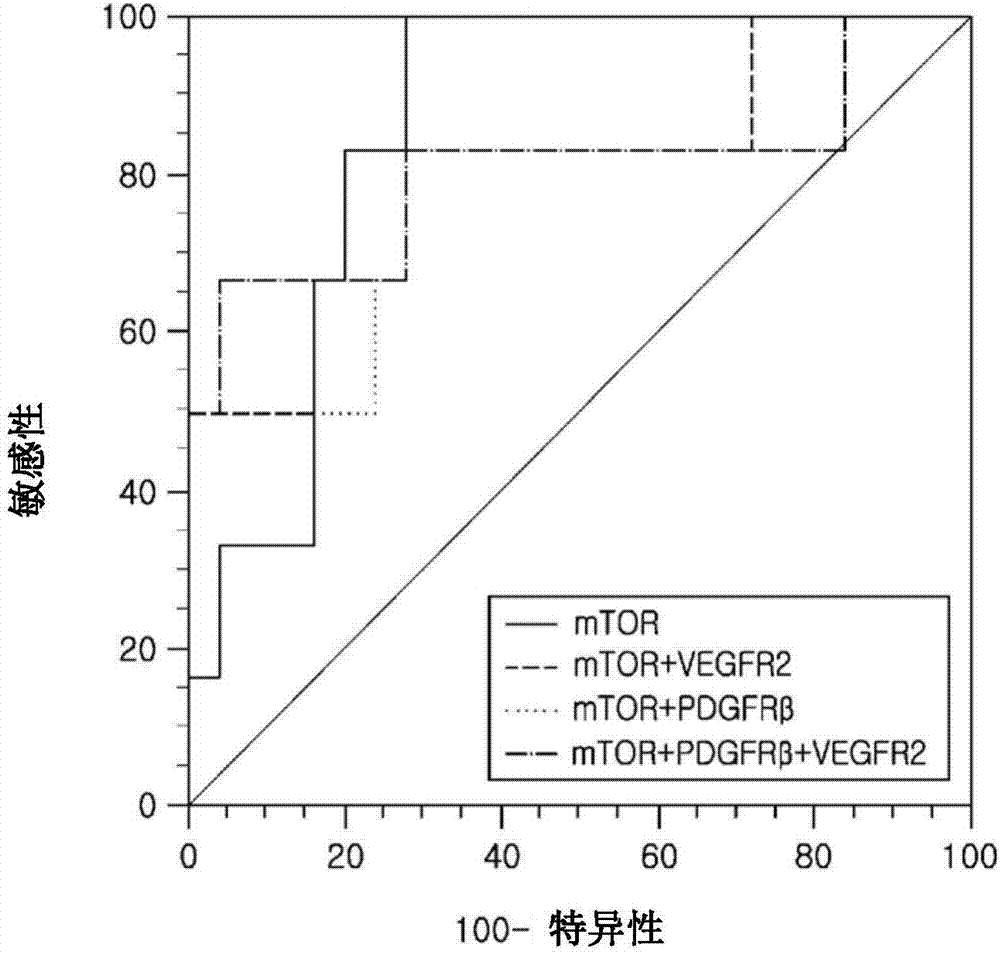Method for predicting sensitivity to vascular endothelial growth factor receptor inhibitor
A growth factor receptor, vascular endothelial technology, applied in the field of predicting the sensitivity of liver cancer patients to vascular endothelial growth factor receptor inhibitor therapy, can solve the threshold and diagnostic performance of not properly assessing resistance or sensitivity, can not Guarantee the treatment effect of guidelines and other issues, and achieve high accuracy and high mRNA levels
- Summary
- Abstract
- Description
- Claims
- Application Information
AI Technical Summary
Problems solved by technology
Method used
Image
Examples
Embodiment 1
[0061] Example 1: RNA extraction and cDNA synthesis
[0062] Thirty-one patients with liver cancer who were diagnosed with liver cancer, underwent liver resection or liver transplantation, showed recurrence of liver cancer, and received Nexavar (Sorafenib) at Ajou University Medical Center, Korea University Annam Hospital, and Keimyung University Dongsan Medical Center Treatment, liver cancer tissues were obtained with informed consent. RNA was extracted from each tissue in the following manner, from which cDNA was synthesized.
[0063] Total RNA was extracted from liver cancer tissues and surrounding normal tissues using the RNeasy Mini Kit (Qiagen, Germany) according to the manufacturer's instructions. The extracted total RNA was quantified using Bioanalyzer 2100 (Agilent Technologies, USA). During the extraction step, RNA extracts are treated with DNase I to remove genomic DNA. Each sample containing 4 μg of total RNA was incubated with 2 μl of 1 μM oligo d(T)18 primer...
Embodiment 2
[0064] Example 2: Quantitative real-time PCR
[0065] In order to measure the mRNA expression level of mTOR, VEGFR2, PDGFRβ, FGFR1, cKIT, EGFR or cRAF of each cDNA sample obtained in Example 1, according to the manufacturer's instructions, using PRISM 7900HT (Applied Biosystems, USA) by real-time PCR amplification Gene markers shown in Table 1 below.
[0066] Real-time PCR analysis was performed using a total volume of 10 μl consisting of 5 μl of 2x TaqMan Gene Expression Master Mix (Applied Biosystems, USA), 1 μl each of 5 μM forward and reverse primers, 1 μl of 1 μM probe (Genotech, Korea) and 2 μl of cDNA (the same amount of water as a control). PCR amplification was performed by denaturation at 95°C for 10 minutes, followed by a cycling reaction consisting of denaturation at 95°C for 15 seconds and synthesis at 60°C for 1 minute. Primer and probe sequences were designed using Primer Express 3.0 (Applied Biosystems, USA), and all probe sequences were labeled with FAM at...
Embodiment 3
[0074] Embodiment 3: statistical analysis
[0075] Using the expression levels of the markers obtained in Example 2 (2 -ΔCt ), a total of four statistical analyzes (ie individual gene expression distribution analysis, ROC curve analysis, treatment benefit score analysis and ROC curve analysis of treatment benefit score) were performed in the following manner.
[0076] (1) Analysis of individual gene expression distribution
[0077] In order to detect the therapeutic effect of Sorafenib and the expression level of a single marker (2 -ΔCT ), the expression levels and distributions of seven individual markers were analyzed for Sorafenib responders and Sorafenib non-responders respectively, and the analysis results are shown in figure 1 .
[0078] figure 1 Results of analysis of mRNA expression levels of seven genes (ie, mTOR, VEGFR2, PDGFRβ, FGFR1, cKIT, EGFR, and cRAF) in responders and non-responders are shown.
[0079] When expression of each of these markers showed: ...
PUM
 Login to View More
Login to View More Abstract
Description
Claims
Application Information
 Login to View More
Login to View More - R&D
- Intellectual Property
- Life Sciences
- Materials
- Tech Scout
- Unparalleled Data Quality
- Higher Quality Content
- 60% Fewer Hallucinations
Browse by: Latest US Patents, China's latest patents, Technical Efficacy Thesaurus, Application Domain, Technology Topic, Popular Technical Reports.
© 2025 PatSnap. All rights reserved.Legal|Privacy policy|Modern Slavery Act Transparency Statement|Sitemap|About US| Contact US: help@patsnap.com



